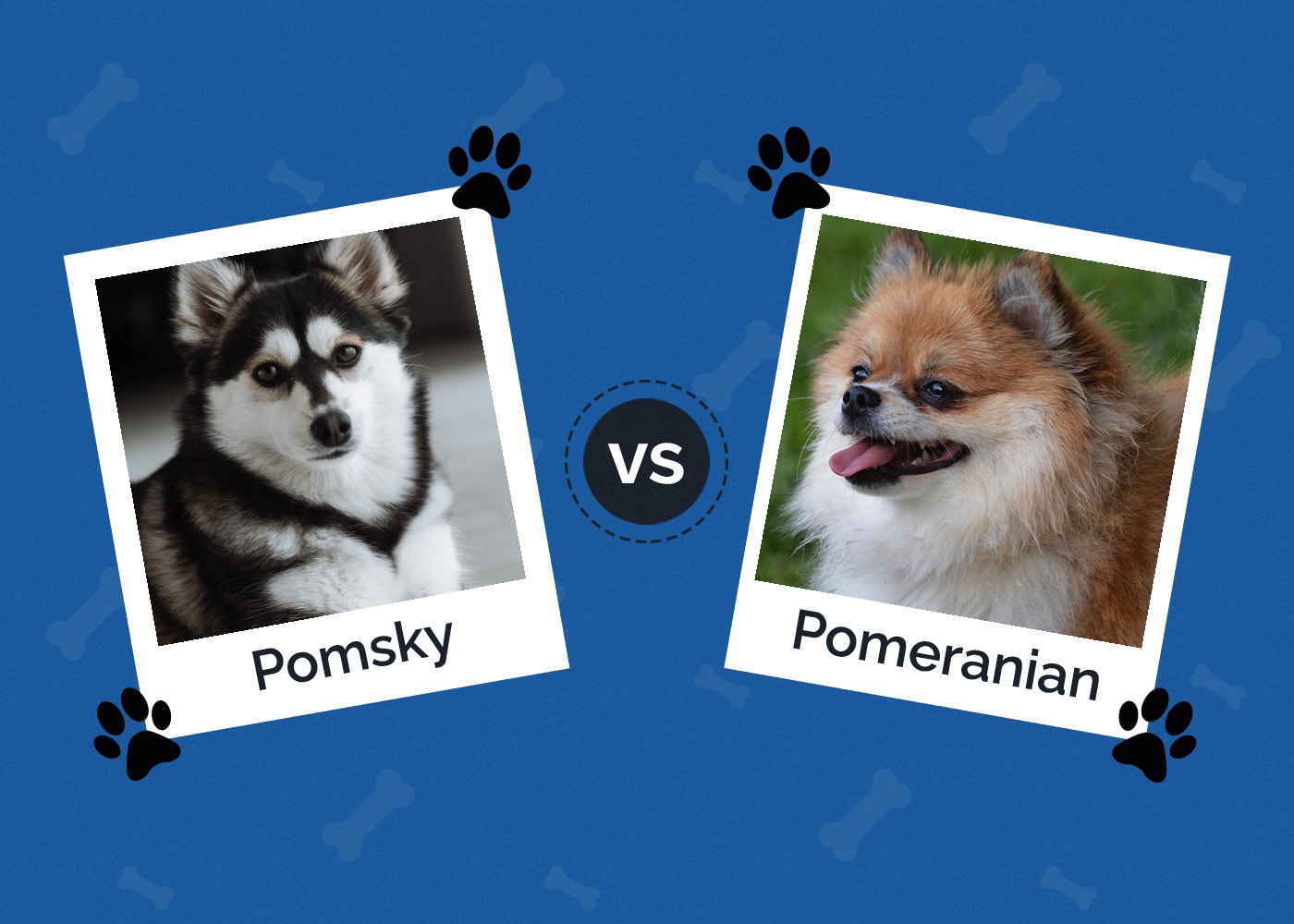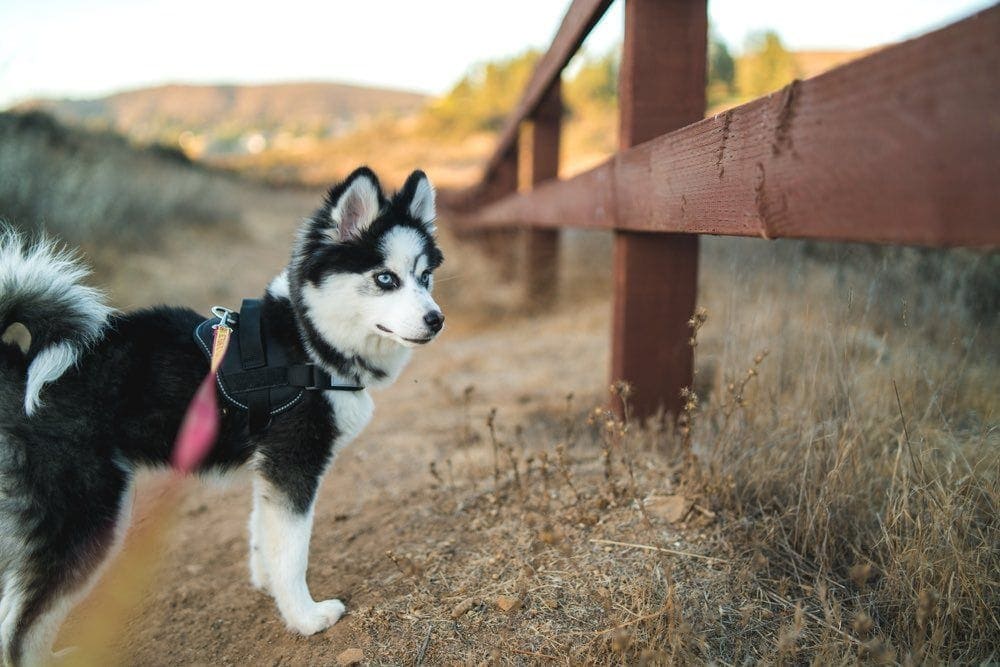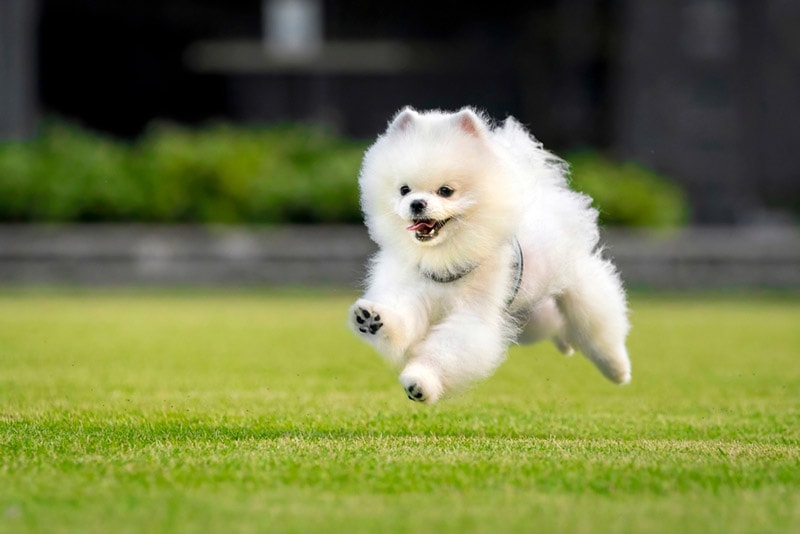Pomsky vs. Pomeranian: The Main Differences (With Pictures)
By Ashley Bates
Updated on

You might not be fully versed in the AKC’s over 400 registered dog breeds. It’s extra hard to keep track of all the designer dog breeds. If you see the Pomeranian alongside the Pomsky, you might wonder a little more about the parent breeds and the personalities to expect from each.
So, what will it be? The classic Pomeranian or the snow dog hybrid? Only you can decide. Here we will give a detailed comparison of both so you can gauge what to expect and discuss why either pup will work for you.
Visual Differences

At a Glance
- Average height (adult): 10–15 inches
- Average weight (adult): 20–30 pounds
- Lifespan: 13–15 years
- Exercise: 2 hours a day
- Grooming needs: High
- Family-friendly: Yes
- Other pet-friendly: Often
- Trainability: Intelligent, adventurous, spunky
- Average height (adult): 8–11 inches
- Average weight (adult): 3–7 pounds
- Lifespan: 12–16 years
- Exercise: 1 hour a day
- Grooming needs: Moderate
- Family-friendly: Yes
- Other pet-friendly: Often
- Trainability: Intelligent but stubborn
Pomsky Overview

The adorable Pomsky is a hybrid of the Husky and Pomeranian. It takes the best of both worlds, resulting in a small to medium-sized dog with a quirky personality and energetic activity level.
Personality / Character
The Pomsky has quite a sprightly personality. These dogs take on the combined traits of both parents, making possibilities virtually endless. Both parent breeds are very high-energy dogs, but Huskies are more challenging.
It’s best to educate yourself on each parent thoroughly so you know what to expect from the puppies. These dogs tend to be curious, loyal, and very pack-oriented. Once you are in the love circle, you’ll have a faithful best friend forever.
Exercise
Your Pomsky will need lots of exercise! Small Pomeranians have bursting energy, but they like to exercise in small bursts. On the other hand, Huskies have boundless energy at any time. These dogs don’t tucker out easily.
So, you can expect to be exercising, but if they take after their Husky parents, you might be on the go constantly. On average, a Pomsky needs an hour to 2 hours of daily exercise. Pomskies who don’t get enough exercise can exhibit destructive behaviors or nervous tendencies.
Huskies are very adventurous dogs that enjoy running around and having fun. So, things can go awry if they have pent-up energy or a lack of stimulation. As a result, Pomskies can be stubborn or destructive and be inclined to run away if given the opportunity.
So always ensure they have an appropriate outlet, and know that the spread is not for the faint of heart.

Training
Your Pomsky might be a little challenging to train, but they are eager to learn. This is a brilliant breed mix, sometimes outsmarting their owners. These dogs are not for first-time or inexperienced folks, as they can be a little overwhelming for some.
They require a firm hand and consistent training. If you’re having trouble establishing boundaries, You can always rely on a professional for help.
But your Pomsky is sure to dazzle you all the time with their brains and brawn. They might be smaller than their Husky parents, but they are just as capable and intelligent.
Health & Care
Because the Pomsky is a mixed breed, they can take on characteristics of both parents. So when shopping for your Pomsky, having a full history of both parents will indicate any genetic issues that could crop up.
If you buy from a reputable breeder, no dog with known health issues should have been used in a breeding program. So it is absolutely crucial to buy responsibly.
- Allergies
- Patellar luxation
- Hip dysplasia
- Collapsing trachea
- Epilepsy
- Heart disease
- Skin issues
- Seizures
With regular vetting, you can stay ahead of the game and treat any health issues as they arise.

Puppies
Because Pomskies are a mixed breed, you need to be very careful with choosing a breeder. Backyard breeding is an unfortunate downfall of hybrid pups, resulting in poor health and temperament. Always research the breeder to ensure quality.
Luckily, because Pomeranians and Huskies are very common breeds, you might get a rescue with these genetics for a fraction of the cost. Also, when you purchase from a rescuer shelter, all vet care is already finished. That cuts out a huge part of the upfront cost.
Suitable for:
Pomskies are excellent for people who lead active lifestyles. This peppy pup will keep you on your toes, ready to go on adventures, hikes, cruises, and jogs. Keep in mind that these dogs are pretty high maintenance and are best suited for experienced owners.
 Pomeranian Overview
Pomeranian Overview

The tiny Pomeranian has been around for many years. These charming little dogs have beautifully long, straight coats, curly tails, and puffy personalities.
Personality / Character
A Pomeranian is known for being very happy-go-lucky and on the move. These small dogs will greet any person who gets in their good graces. In some cases, they might take a second to warm up, keeping a watchful eye to ensure no danger is eminently affecting their family.
These little social dogs have pretty good discernment, especially if they have early training. They can be lap dogs, very attached to owners. They might have trouble being left alone. Separation anxiety can vary in severity, so it’s best if someone is home most of the time.
Exercise
Poms require moderate exercise, totaling roughly an hour per day. Because these little dogs do best in short bursts, you can break up the time in intervals throughout the day.
Your Pom will love going on a morning stroll or evening walk while playing tug-of-war and other fun games in between. Make sure to give them proper stimulation, as these dogs require an adequate outlet to curb anxious tendencies.

Training
Because Pomeranians are so headstrong, they could be challenging to train. It isn’t because they lack intelligence or know-how. They simply have a mind of their own. Remember to train with a firm hand, but be careful not to use any extreme punishments.
These dogs are highly sensitive to negative attention. And you will soon find out it is very unnecessary. So try to refrain at all costs from swatting at and spanking your Pomeranian.
Health & Care
Pomeranians are typically very healthy little dogs. To ensure prime health, always buy from a reputable breeder, as they must have certain genetic testing and health guarantees. Regular vetting can detect or prevent serious illnesses from occurring.
Always make sure to take your Pomeranian to every scheduled vet appointment to accomplish care such as deworming, flea treatment, vaccinations, routine care, spay or neuter surgery, and microchipping.
- Luxating patella
- Tracheal collapse
- Heart disease
- Obesity
- Skin conditions
- Seizures
Most genetic issues can be avoided when buying from a licensed, reputable breeder.
Puppies
If you buy a Pomeranian from a licensed breeder, you can expect to spend between $600 and $1,200. It greatly depends on quality, breeder rates, appearance, and bloodlines. If puppies are much less, steer clear. It could signal poor breeding practices that could result in unhealthy pups.
Since Poms are so common, you might find one in a rescue or shelter. If so, you can go through the application and adoption process to bring home your new pal. They might not be a cute, fluffy puppy, but they will be eternally grateful for a second chance at life.

Suitable for:
These small, spunky dogs work in just about any living situation. They are little enough to meet the weight requirements for most apartment complexes. Plus, these little cuties are suitable for both children and seniors.
Breed Pros & Cons
Here’s a good look at what’s fantastic and not-so-fantastic about these charming dogs.
Pomsky
- Adventurous
- Social
- Half the size of standard Huskies
- Incredible markings
- Loyal
- Escape artists
- Might be destructive without proper outlets
- Sheds continually
Pomeranian
- Considered a toy breed, small enough for most living spaces
- Very amiable
- Considered “lap dogs”
- Adorable appearance
- Cuddly
- Eager to please
- Might suffer from separation anxiety
- Fragile
- Might bark often
Which Breed Is Right for You?
The Pomsky and Pomeranian are similar in many ways. However, Pomskys get much bigger than their toy parent and have many Husky quirks. Since they are hybrids, outcomes are somewhat unpredictable in size and personality, but they will undoubtedly be on-the-go dogs and are best for active lifestyles.
Pomeranians are toy breeds that are dainty and cheerful. This breed is ideal for many living situations and personalities. These little guys might bark a lot in some cases because they make exceptional watchdogs, but it’s manageable in most cases.
No matter which you choose, these breeds are the total package. Remember to buy from a reputable breeder to ensure a happy, healthy pup.
Featured Image Credit: (L) Max Maximov, Shutterstock | (R) Trent Pickering, Unsplash

 Pomeranian Overview
Pomeranian Overview











